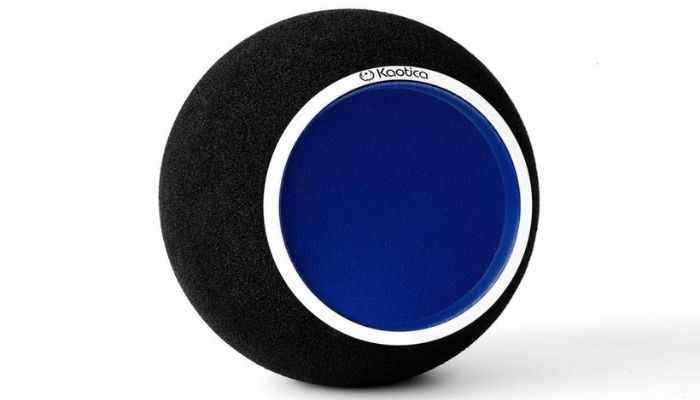It did not miss our eye that every time something big happens, that threatens the established, aristocratic order of all things, it stirs up the mud. We have heard a lot of opinions and not everything positive regarding Kaotica’s Eyeball. Why is this supposed to be? One word is the concern that audio recording will become more democratic.
This is always the reaction of the elderly guard when some new technology comes in that lowers the entry fee for young producers to the point that someone can make the hit tracks (Skrillex anybody?) with a laptop, a $100 I/O, a $100 MIDI, a proper mic, and a copy. Enter the Eyeball of Kaotica. An apparently trivial gimmick that arrived with minimal notice somewhere around 2012.
The Kaotica Eyeball has an integrated pop filter, and a microphone isolation ball. It is a large sphere of foam that you insert through the microphone capsule to guard against reflection. The eyeball is intended for clearer, consistent recording to keep room sound from your vocal tracks.
The concept behind the Eyeball is that it avoids the vocalist having to struggle against an amateur attack on the reflexes of the room when he records vocals. But why was so much energy dismissed in the Eyeball?
Many sound shields such as sE, Sterling’s VocalShield, Prime Acoustic, etc. are included. No one is disturbed by these offers too hard because they do not even come close to a real solution. They, therefore, represent no real threat. These reflection filters only deal partly with the problem of room reflection instead of the true problem… The room itself is untreated.
When Kaotica came to the Eyeball, she used the absolute quintessence of outside of the box. They seem to have suggested that, instead of trying to decrease the quagmire of destructive waves and sound reflections in a room by protecting a tiny region of the microphone, “how we control the microphone by putting a f*ck in place.” Thus the vocalist directly transforms her voice into a regulated and microcosmic environment with the microphone. The eyeball is essentially the space.
You know what, and you know what? It works, indeed. Actually, quite good.

Upgrade
Let’s go over the really easy process of building the Kaotica Eyeball.
First, you remove the blue disc from the front, a double-level pop filter that allows you to enter the eyeball interior. Kaotica says the following on their website: “Do not press it in from the ground, as the thickest section of the microphone is on the inside of the front cavities via the top of the microphone opener.” That’s so that you don’t rip the opening in the wrong way (or forbid God). Most mics will fit into the hole, with practically all of the large-diaphragm condensers definitely from 1.5″ to 2.75,” according to Kaotic.
Please make sure that the microphone sits with the front diaphragm (The gold dot on the Rode or the blue pop screen replaces the red symbol on the Neumann) – (a very tight fit). On the shock mount cage, the eyeball should sit comfortably.
We decided to use eyeball with an OE pop-screen, although it should be encouraged to employ a Steadman ProScreen or equivalent over the standardized filter if you have an excessively plosive-specific voice. However, this will probably not be necessary due to the completely closed architecture as there are no breaches for those that blast B’s and Ps. We saw this as the perfect compromise with strong rappers.
The greatest outcomes for most singers are to put them as close as feasible to the blue popcorn, enhancing the voice that enters the eyeball and reducing every reflected sound by entering the mic.
You will definitely detect a small increase in gain on any microphone when using the eyeball. That is because of the area around the Mic capsule that channels the foam. This is readily addressed by reducing your preamp or interface’s input gain.
We found the TLM and the U87 fairly similar with a sensation possibly a bit warmer in the bottom middle of the 87. The Telefunken’s bubble was virtually totally unknown and tested AK47 and 103, with singing, rapping and voiceovers, kept most of their original sound and character. The minute the midrange increases, which differs between microphones. We didn’t find this a very significant problem because you won’t doubt it is EQ that this range varies by no more than ±1.4dB to 30 kHz as a typical technique, and according to Kaotica.
Perhaps the most striking improvements were found in all the microphones of the NT1a. The usually jagged Rode’s highs have been nearly totally nullified in voice-over work. The NT1a proved nearly unusable for vocalization in a wide wooden floor chamber that was broader than deep. It is a sensitive capsule that collects room noise masses including loud computer fans. The ambient noise was reduced by more than 10dB (±2dB).
A very welcome improvement on the mics tested was the considerable reduction in background noise and ambient noise, and many will find the difference between ‘going along and not.
Conclusion
One of the main assets and the capacity to deflate the sound of your recording area is the unusual ‘gimmicky’ form of the Eyeball. Until now a transient designer (most commonly SPLs) and the Izotope RX5 DeReverb module have been the most important instrument for coping with a missing room (see our iZotope RX5 review). This way you can get away with a good deal, but there is no denial — this is so-called cleanup. At 198 dollars the Eyeball looks costly but honest? In nearly any context, how much are outstanding vocals worth to you?
